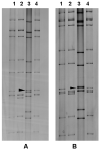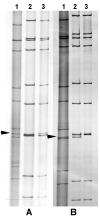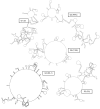Acrylamide concentration affects the relative position of VP7 gene of serotype G2 strains as determined by polyacrylamide gel electrophoresis
- PMID: 18457989
- PMCID: PMC2574723
- DOI: 10.1016/j.jcv.2008.03.019
Acrylamide concentration affects the relative position of VP7 gene of serotype G2 strains as determined by polyacrylamide gel electrophoresis
Abstract
Background: During the course of development and characterization of various rotavirus reassortants, we found that the relative position of the gene encoding neutralization and protective antigen VP7 of certain rotavirus strains in a PAGE gel was influenced by the concentration of acrylamide.
Objectives: We investigated systematically various factors that affected the relative position of the rotavirus VP7 gene in a PAGE gel.
Study design: We analyzed dsRNAs of selected rotavirus strains bearing G1, G2, G3 or G9 specificity by PAGE at varying concentrations of acrylamide.
Results: We demonstrated that the relative position of the VP7 gene of three G2 strains varied depending upon the concentration of acrylamide in a PAGE gel, which occurred not only in a homologous G2 virus gene background but also in a heterologous G3 virus gene background; and the VP7 gene bearing G1, G3, G4 or G9 specificity did not display this phenomenon when the PAGE running conditions were varied.
Conclusions: The concentration of acrylamide in a PAGE gel was the major factor that influenced the relative position of the VP7 gene of G2 rotavirus strains (i.e., VP7 gene coding assignment by PAGE).
Figures





Similar articles
-
Concentration of acrylamide in a polyacrylamide gel affects VP4 gene coding assignment of group A equine rotavirus strains with P[12] specificity.Virol J. 2010 Jun 23;7:136. doi: 10.1186/1743-422X-7-136. Virol J. 2010. PMID: 20573245 Free PMC article.
-
[Molecular epidemiologic survey of rotaviruses from infants and children with diarrhea in Shanghai].Zhonghua Er Ke Za Zhi. 2004 Jan;42(1):10-5. Zhonghua Er Ke Za Zhi. 2004. PMID: 14990097 Chinese.
-
Rotavirus serotype G9 strains belonging to VP7 gene phylogenetic sequence lineage 1 may be more suitable for serotype G9 vaccine candidates than those belonging to lineage 2 or 3.J Virol. 2004 Jul;78(14):7795-802. doi: 10.1128/JVI.78.14.7795-7802.2004. J Virol. 2004. PMID: 15220453 Free PMC article.
-
VP7 gene polymorphism of serotype G9 rotavirus strains and its impact on G genotype determination by PCR.Virus Res. 2003 May;93(1):127-38. doi: 10.1016/s0168-1702(02)00318-0. Virus Res. 2003. PMID: 12727352
-
Preferential selection of heterologous G3-VP7 gene in the genetic background of simian rotavirus SA11 detected by using a homotypic single-VP7 gene-substitution reassortant.Antiviral Res. 1998 Apr;38(1):15-24. doi: 10.1016/s0166-3542(98)00006-0. Antiviral Res. 1998. PMID: 9614000
Cited by
-
Concentration of acrylamide in a polyacrylamide gel affects VP4 gene coding assignment of group A equine rotavirus strains with P[12] specificity.Virol J. 2010 Jun 23;7:136. doi: 10.1186/1743-422X-7-136. Virol J. 2010. PMID: 20573245 Free PMC article.
-
Dual selection mechanisms drive efficient single-gene reverse genetics for rotavirus.Proc Natl Acad Sci U S A. 2010 Oct 26;107(43):18652-7. doi: 10.1073/pnas.1011948107. Epub 2010 Oct 11. Proc Natl Acad Sci U S A. 2010. PMID: 20937889 Free PMC article.
References
-
- Clark HF, Offit PA, Ellis RW, Eiden JJ, Krah D, Shaw AR, Pichichero M, Treanor JJ, Borian FE, Bell LM, Plotkin SA. The development of multivalent bovine rotavirus (strain WC3) reassortant vaccine for infants. J Infect Dis. 1996;174(Suppl):S73–S80. - PubMed
-
- Das BK, Gentsch JR, Hoshino Y, Ishida S-I, Nakagomi O, Bhan OM, Kumar R, Glass RI. Characterization of the G serotype and genogroup of New Delhi newborn rotavirus strain 116E. Virology. 1993;197:99–107. - PubMed
-
- Espejo RT, Puerto F. Shifts in the electrophoretic pattern on the RNA genome of rotaviruses under different electrophoretic conditions. J Virol Methods. 1984;8:293–299. - PubMed
-
- Estes MK, Kapikian AZ. Rotaviruses. In: Knipe DM, Howley PM, Griffin DE, Lamb RA, Martin MA, Roizman B, Straus SE, editors. Fields Virology. 5th ed Lippincott Williams and Wilkins; Philadelphia, PA: 2007. pp. 1917–1974.
Publication types
MeSH terms
Substances
Grants and funding
LinkOut - more resources
Full Text Sources

